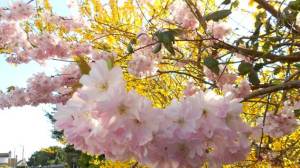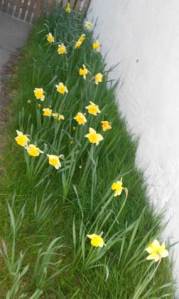Genus: Euphorbia (Family: Euphorbiaceae), Species covered: amygdaloides, characias, x martinii
Euphorbias started out as my husband’s “thing” and we even own the RHS Wisley Handbook about this group of plants. While it is a large genus, many of its species are not hardy in the UK, so the handbook is actually of reasonable size (and price). Planted originally solely in response to Simon’s boundless enthusiasm, most of our euphorbia’s have truly earned their keep in the garden as their are hardy, resilient and have long season’s of interest, so there will be several blogs showcasing different subgroups we have in the garden.
You should be aware that the milky sap is toxic and an irritant, which apparently some people can react very strongly to, so you should wear gloves and long sleeves when planting, pruning and otherwise interacting with these plants, as well as carefully considering whether animals and children might get in contact with them when choosing a planting site. I once ended up with a sap burn on the inside of my arm, which was no worse than a scratch, but sensitivities can vary and you most definitely do not want any sap near your face/eyes. We did worry about our dog crashing through the larger euphorbias and getting covered in sap, but she tends to stay out of the flowerbeds, so this has not been a problem. The sap is apparently also highly toxic to fish, so you should not plant a euphorbia close to an ornamental pond, and it can gum up your secateurs, meaning anvil ones are better than bypass, and all should be cleaned well after pruning.
While that doesn’t sound much like fun, the large evergreen euphorbias really are very attractive and provide year-long structure, as well as interesting flowers in spring. The handbook would like me to point out that the stems for these species are actually never older than two years, making them biennial-shooted evergreens (there is a group of “proper” evergreen euphorbias as well), but, provided you prune out the dead flowering shoots, I would call them “functionally evergreen”.
As the title of this post indicates, I want to start with the large euphorbias in this group.
Euphorbia characias subsp. wulfenii is the most architectural species we have, and it really has grown into a substantial feature, as you can see in the photo at the top. We also have a Euphorbia characias “Humpty Dumpty” and more recently acquired a Euphorbia characias “Portugese Velvet”, which has furry and tactile-looking leaves and will hopefully not grow quite as big (it’s in a raised bed at the moment).
We also have a Euphorbia amygdaloides var. robbiae, which is happily colonising a shady corner, and what looks like a Euphorbia amygdaloides“Purpurea” in the front garden. The former tends to pop up as runners over quite a long range and needs to be kept in check, but this is good if you want to propagate the plant. One of my Purpureas went through a phase of looking quite sickly and I’ve removed one last year, but the other one, in a very sunny site, is doing surprisingly well at the moment – apparently they can be quite weak.
Finally, we have a Euphorbia “Efanthia” in the front garden, which appears to be another hybrid of E. amygdaloides.
It is common for E. characias and E. amygdaloides to hybridise and these are collectively known as E. x martinii. While I think we may have lost one the unnamed hybrids in my database, we bought a E. x martinii“Ascot Rainbow” last year and it is developing into an attractive feature in the grasses bed.
If you can put up with the sap and accommodate the exuberant growth, these large, evergreen euphorbias make an attractive garden plant, combining interesting flowers with good structure. They seem to be able to shrug off aphids and rust, and I haven’t seen mine suffer from mildews (yet).
























